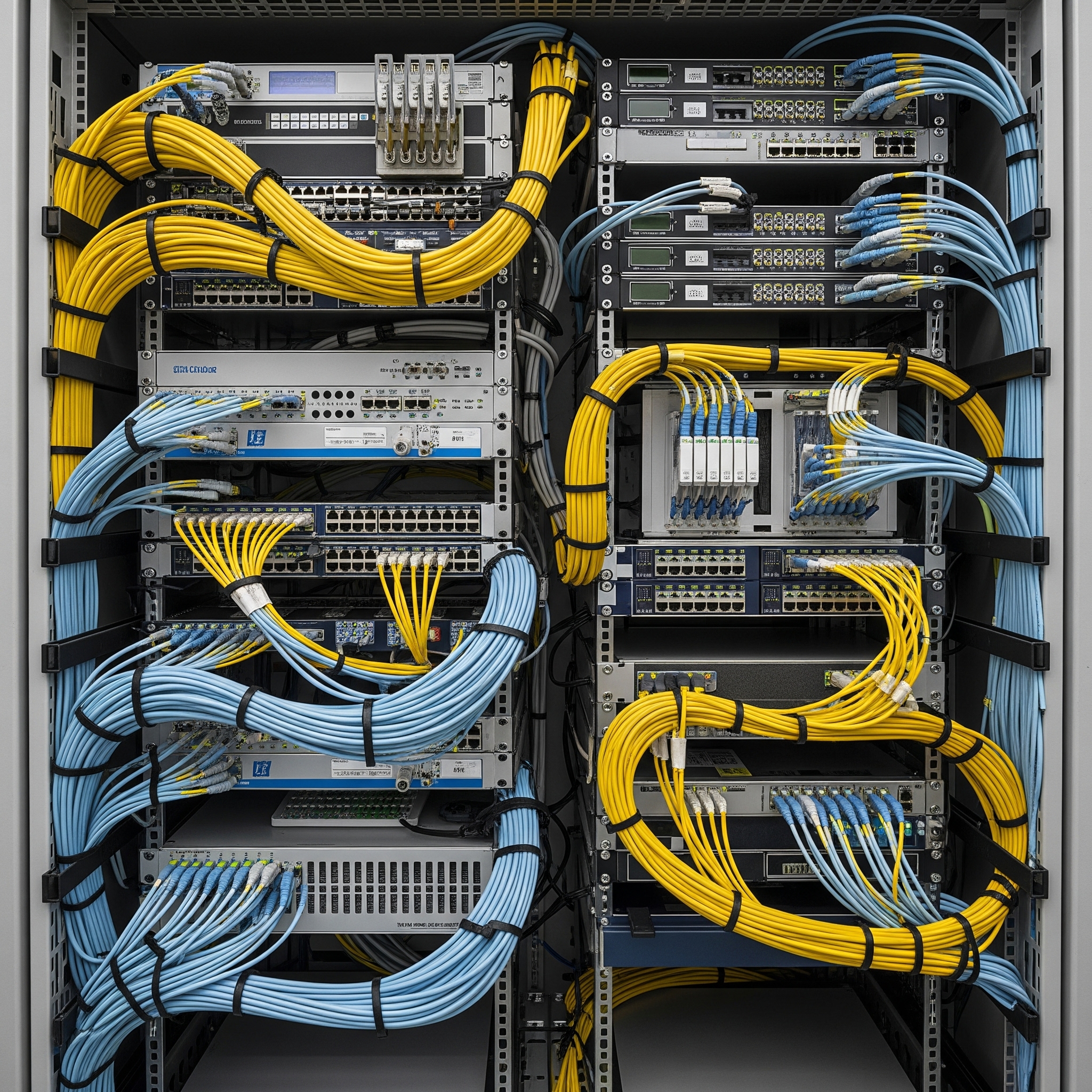Fiber Optic Cable Management Best Practices

Proper fiber optic cable management is essential for maintaining performance, reducing signal loss, and ensuring long-term reliability in high-density environments like data centers and enterprise networks.
1. Technical Best Practices
Maintain Minimum Bend Radius
Exceeding the minimum bend radius can cause signal loss and permanent damage to fiber optic cables:
- Single-mode fiber: 10x diameter under load, 20x when static
- Multi-mode fiber: 10x diameter under load, 15x when static
- Use radius guides, trays, and slack spools to maintain compliant paths
- Avoid sharp corners or pulling against fixed objects
Control Pulling Tension
Excessive pulling tension can damage fiber cores and degrade performance:
- Follow manufacturer pulling tension ratings (typically 600N for distribution cables)
- Use swivel pulling grips and lubricants for long conduit runs
- Maintain smooth, steady pulls to reduce microbending
- Never exceed 1,500N pulling tension for standard indoor cables
Route and Isolate
Proper routing prevents interference and physical damage:
- Use dedicated fiber trays or ducts separate from copper or power cables
- Route horizontally and vertically with consistent standards
- Maintain minimum 6-inch separation from high-voltage power sources
- Use plenum-rated cables in air handling spaces
Modular and High-Density Hardware
Modern fiber management requires scalable, high-density solutions:
- Deploy cassettes (LC, MTP/MPO) with modular patch panels
- Use rack-mounted enclosures with front/rear access
- Allow room for adds/moves/changes without disrupting existing fibers
- Implement color-coding standards for different fiber types and applications
Clean and Inspect Connectors
Contaminated connectors are the leading cause of fiber network problems:
- Enforce a "clean before connect" policy for all connections
- Use dry-clean pens, inspection scopes, and lint-free wipes
- Terminate in clean environments and protect connectors with dust caps
- Inspect end-faces with 400x magnification before making connections
2. Operational Best Practices
Pre-Design Cable Paths
Proper planning prevents installation problems and future limitations:
- Plan with CAD or DCIM tools for route clarity and future capacity
- Avoid overfilling trays (50% fill ratio maximum recommended)
- Document all pathways, lengths, and ports in detail
- Consider future expansion needs in initial design
Bundle by Function
Organized bundling improves maintainability and reduces errors:
- Use hook-and-loop fasteners—never zip ties which can cause stress
- Bundle cables by application (intra-rack, inter-rack, uplink)
- Label both ends with port/rack/zone identifiers and color codes
- Maintain consistent bundle sizes (typically 12-24 fibers per bundle)
Slack Management and Accessibility
Proper slack management enables maintenance and future changes:
- Leave 1–2 meters of slack per connection point for service loops
- Use dedicated slack trays or boxes—do not coil inside enclosures
- Keep patch cords long enough for service loops but short enough to avoid clutter
- Ensure all connections remain accessible for testing and maintenance
Schedule Regular Inspections
Proactive maintenance prevents problems and extends system life:
- Create quarterly cable audits for cleaning, tension checks, and patch integrity
- Use DCIM systems to reconcile physical layout vs. logical records
- Log MACs (Moves/Adds/Changes) to keep infrastructure documentation accurate
- Perform optical loss testing annually or after any physical changes
3. Business Benefits of Strong Cable Management
Proper fiber management delivers measurable business value:
- Accelerated Installations: Mapped, labeled paths speed up technician work by 40%
- Downtime Avoidance: Prevents patching errors and supports network resilience
- Cost Control: Reduces labor costs and prevents premature component replacement
- Audit and Compliance Readiness: Supports documentation and inspection requirements
- Strategic Scalability: Enables growth with modular pathways and high-density designs
Pro Tip
Implement a comprehensive labeling system from day one. Use machine-printed labels that include rack location, port numbers, and destination information. This small investment in organization pays dividends during troubleshooting and maintenance activities.
Conclusion
Cable management is foundational—not optional—for reliable network operations. With proper planning, execution, and maintenance, organizations can minimize downtime, improve serviceability, and enable long-term scalability.
At Wave2Wave.io, we help data centers and network operators deploy fiber systems engineered for growth, clarity, and resilience. From pre-labeled kits to DCIM-integrated layout validation, we bring structure to every strand.
Need Expert Fiber Infrastructure Design?
Let our specialists help you implement structured, scalable fiber systems tailored to your operation.
Talk to Our Team